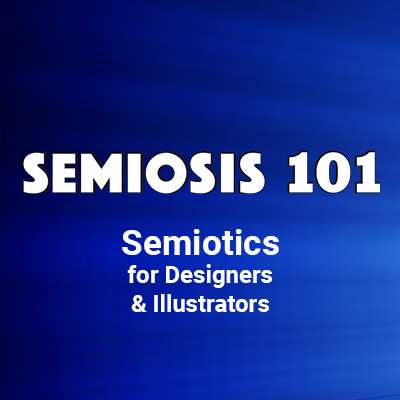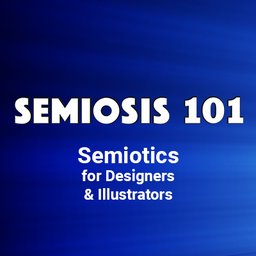BLOG 18: Semiotically Mediating Tone of Voice

Semiosis 101 - 5 minute semiotic read
When you apply semiotic signs in your illustrations and designs you are in fact manipulating your visual language to mediate the visual communication of what was meant to be communicated. We are no longer concerned with denotational meaning but instead connotatively visually expressing deeper concepts in subtle ways.
Anyone can create a visual and state “This Symbolically actually means that other thing! If you do not agree then you are an idiot for not seeing MY artistic genius!” But that is not what I am discussing. That cliche of ‘artistic genius’ is not helpful as that is a broad-brush example of first-order thinking. That is first-order thinking (essentially a ‘god-view’) that everyone else sees and thinks like the creator thinks. No. What I am discussing here is the semiotic manipulation of a mediated tone of voice.
Designers and illustrators are both visual communicators but their practice
differs. In commercial design and illustration practice (as opposed to fine artists’ practice), everything begins with the client. They commission the creative to solve a design problem for them with a brief outlining what is needed.
Graphic designers manipulate type and image to visual communicate. Illustrators produce images to be used with type at some point. They design for the client’s target audience. It is the audience who will arbitrate the success. One important commonality they share is the crafting of visual language to answer the brief’s requirements.
You may call visual language ‘the aesthetic,’ ‘visual style,’ ‘colour palettes,’ ‘branding guidelines,’ ‘creating the mood,’ ‘setting the tone,’ or just ‘tone of voice.’ Whatever you call it, it is semiotically mediated. You can manipulate it. Your visual language is made up of marks, typefaces, colours, shapes, lines, etc. nested and composed into more complex meaning-bearing visual elements.
When visually composed in various ways this visual language produces sophisticated imagery and design outcomes that visually communicate messages your client needs visually communicated.
If your design’s or illustration’s aesthetic does not hook and retain the attention of your target audience, then your client’s needs will not be met. Semiosis is not concerned with whether your client’s needs are information to share, an event to promote, a story to tell, or action calls to buy a product.
Applied pragmatic semiotic sign-action into your creative processes is only concerned with structuring how effectively you can visually communicate the desired messaging. Semiosis is an open-ended process to craft how meaning can be visually communicated. Semiosis offers the creative a qualitative process of improving any visual meaning-bearing elements.
Does the few brush strokes in an illustration visually communicate a tree, or does it look like something else?
Does the composition of several graphic elements in a page layout support the tone of voice and theme, or does the negative space between the elements now look like a Nazi swastika?
The structure that a strong ideation process, within a larger creative process of diverge/converge/diverge/converge, offers designers and illustrators a scalable, repeatable professional work plan.
With each interpreted moment the audience has, their interpretation of meaning is dependent on the tone of voice your visual language decisions has set. How you semiotically represent your client’s desired concept mediates the audience towards an understanding formed from their prior experiences.
Your visual language helps to provide the appropriate semiotic contexts to eventually mediate the audience only to your intended concept. This acknowledgement of the audience’s incremental understanding of meaning is crucial to a healthy semiotic mindset.
At a visually tonal level of semiotic communication, the context for the desired tone is dependent on familiar qualities which instantly puts in the mind of the audience a possible meaning. Incrementally, if your audience then perceives there is more to understand than a possible familiar tone, then the semiotic sign-action mediates more contextual clues to what is being visually communicated.
From a feeling of tone, further meaning is contextually mediated from the nested semiotic signs. The only thing that has changed within this moment is that the audience’s perception has changed. Your design or illustration remains unchanged. I expand on this in my 2026 Semiotics for Designers and Illustrators book, and in many Semiosis 101 episodes on YouTube and Patreon.





